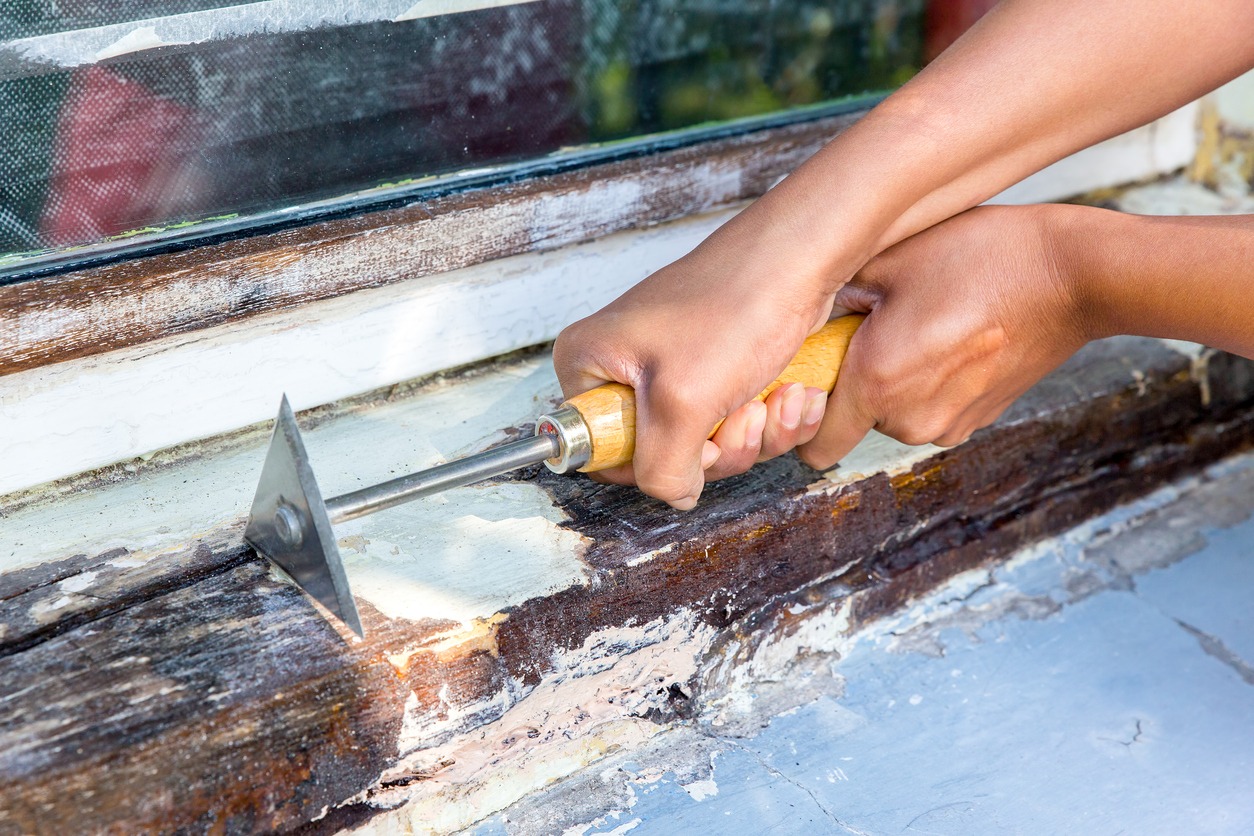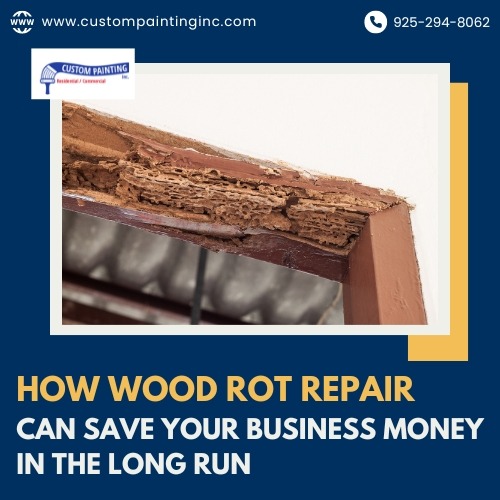Wood rot is a serious issue that can affect commercial buildings with wooden structures, but what causes it? It is fungi that grow on wood in moist and warm conditions, breaking down the wood and causing it to weaken and decay.
Wood rot can lead to structural damage, potentially creating safety hazards and costly repairs. If you own a commercial building with wooden structures, you must be vigilant about moisture control, conduct regular inspections, and do the necessary maintenance to prevent or mitigate wood rot.
Understanding wood rot
What is wood rot, and what are the conditions that cause it?
Wood rot is the deterioration of wood caused by fungi, which thrive in moist environments. The fungi break down the wood’s cellulose and lignin, weakening it and causing it to decay.
Conditions that cause wood rot:
- Moisture – High levels of moisture or dampness in the wood create an ideal environment for fungal growth.
- Poor ventilation – Lack of air circulation can contribute to dampness and moisture retention.
- Warm temperatures—Fungi thrive in moderate to warm temperatures, typically between 20°C and 30°C (68°F and 86°F).
- Wood in contact with soil – Soil contact can expose wood to moisture and fungi present in the soil.
Types of wood rot
1. Dry rot:
- Caused by the fungus Serpula lacrymans.
- Prefers dry or slightly damp wood.
- Spreads rapidly and can weaken the structure of wood.
- It produces a distinct musty smell and can cause wood to crumble or crack.
2. Wet rot:
- Caused by various fungi, including Coniophora puteana and Fibroporia vaillantii.
- Requires high levels of moisture to thrive.
- It causes wood to soften or darken, often producing a spongy or fibrous texture.
- Typically, it spreads more slowly than dry rot.
Early signs of wood rot to look out for on business premises
- Discoloration – Wood may become darker or lighter in color.
- Softening – The wood may feel soft or spongy to the touch.
- Cracking or splitting – Wood may begin to crack or split, especially along the grain.
- Fungus growth – Visible mold or mildew on wood surfaces.
- Musty odor – A strong, unpleasant, musty smell may indicate wood rot.
- Warping – Wood may become warped or deformed.
The immediate and long-term costs of ignoring wood rot

Immediate costs
Untreated wood rot can result in immediate costs and dangers, including:
- Structural damage – Rot weakens wooden structures such as beams, joists, and support columns, leading to sagging floors, buckling walls, and potential collapse.
- Safety hazards – The weakening of structural components poses risks to building occupants and visitors, potentially leading to injury.
- Increased repair costs – Addressing wood rot in its later stages can involve expensive repairs, including replacing affected structures.
- Mold growth – Wood rot often accompanies moisture issues, which can encourage mold growth, leading to health issues for occupants.
- Decreased property value – Buildings with significant wood rot can lose value due to their perceived poor condition.
Long-term costs
- Structural damage – Wood rot weakens a building’s structural integrity. When rot affects load-bearing elements such as beams, joists, or supports, it compromises the safety and stability of a structure, leading to expensive structural repairs.
- Spread of damage – Wood rot can spread quickly to other areas if not addressed promptly. It can affect other wooden components, such as floors, walls, or roofs, increasing the scope and repair costs.
- Pest infestation – Rotting wood attracts pests like termites and carpenter ants, which can cause further damage and incur additional pest control costs.
- Health risks – Mold and mildew thrive in areas with wood rot, leading to potential health issues for occupants and the need for costly mold remediation.
- Decreased property value – Properties with wood rot may decrease in value due to the perception of poor maintenance and potential safety hazards.
- Insurance premiums – Extensive damage caused by neglecting wood rot might increase insurance premiums or lead to difficulty in obtaining coverage.
- Expensive repairs – The longer wood rot is ignored, the more extensive and costly the repairs will be. Replacing large sections of wood or entire structures can be much more expensive than addressing minor issues early.
Case studies or examples of businesses that faced significant costs due to neglected wood rot
Wood rot can be a costly problem for businesses, particularly those in industries that use wood in their structures, such as construction, agriculture, or hospitality. Here are some case studies or examples of businesses that faced significant costs due to neglected wood rot:
1. Historic buildings
Case study: A historic hotel in New Orleans faced significant costs due to neglected wood rot. The rot had damaged the foundation and walls, causing structural instability and needing costly renovations. It also led to the hotel being temporarily closed, resulting in lost revenue.
2. Agricultural industry
Example: Farms with wooden barns and silos can experience significant losses due to neglected wood rot. In one case, a farmer had to replace an entire barn because the structural beams were severely rotted, posing a risk to livestock and workers.
3. Retail and commercial properties
Case study: A commercial property in a downtown area suffered from wood rot in its wooden roof. It led to leaks and damage to merchandise and potential safety hazards for customers and employees. The business faced significant costs for repairs and loss of sales during the renovation.
4. Residential property development
Example: A property developer faced legal issues and financial losses after selling homes with wood rot in the siding and framing. Homebuyers filed lawsuits due to safety concerns and repair costs, leading to substantial legal fees and settlements for the developer.
5. Marinas and boating
Case study: A coastal marina faced substantial costs when the wood pilings and docks began to rot. This not only required expensive repairs to replace the pilings and docks but also disrupted marina operations and inconvenience for boat owners.
The Benefits of Early Wood Rot Repair
Early wood rot repair offers several benefits that can help preserve the wooden structures’ integrity and aesthetics. Here are some key benefits of repairing wood rot early:
- Cost savings – Addressing wood rot in its early stages can save money in the long run. Early repair prevents further damage and avoids extensive and costly repairs or replacements later.
- Structural integrity – Wood rot can weaken the structure of wooden elements, such as beams, joists, and supports. Early repair helps maintain the structure’s strength and stability, preventing potential safety hazards.
- Aesthetics – Early repair can help maintain the wooden structures’ visual appeal. Rotted wood can become discolored and unattractive, and prompt repair helps preserve the wood’s natural beauty.
- Prevention of spread – Wood rot is caused by fungi, which can spread to other parts of the structure if left untreated. Early repair stops the fungi from spreading and causing more damage.
- Increased lifespan – Repairing wood rot early can extend the lifespan of wooden structures and prevent premature deterioration.
- Improved safety – Wood rot can compromise the safety of wooden structures, especially in load-bearing components. Early repair ensures the safety of the structure and its occupants.
- Pest prevention – Wood rot can attract pests such as termites and carpenter ants. Early repair can help prevent infestations that can cause further damage.
- Compliance with building codes – In some areas, local building codes may require proper maintenance and repair of wooden structures. Early repair ensures compliance with these regulations.
Wood rot repair as a preventative measure
Business owners should do regular inspections to address wood rot issues early before they escalate and cause serious damage to wooden structures. Here’s how regular inspections and maintenance can help:
- Identifying early signs of rot – Routine checks can uncover early signs such as discoloration, softness, or crumbling wood. Addressing these issues early prevents further damage.
- Ensuring proper ventilation – Proper airflow helps keep wooden structures dry, reducing the risk of rot. Inspections can ensure vents and openings are clear and functioning properly.
- Applying protective coatings –Regular maintenance includes applying paint, stain, or sealant to protect wood from moisture, UV rays, and other elements.
- Checking for leaks – Inspecting areas around windows, doors, and roofs for leaks prevents water from seeping into wooden structures.
- Cleaning and clearing – Keeping gutters and downspouts clear ensures proper drainage and prevents water from pooling around wooden structures.
- Trimming vegetation – Ensuring plants and trees are trimmed back reduces the risk of moisture from foliage and root systems affecting wood.
Professional assessment and repair services play a crucial role in maintaining the integrity of wooden structures. These experts can provide:
- In-depth inspections – Professionals can conduct thorough assessments and identify underlying issues not immediately apparent during routine checks.
- Expert repairs – They can perform precise repairs using appropriate materials and methods, ensuring long-lasting solutions.
- Restoration – When significant damage occurs, professional services can restore wooden structures to their original condition.
- Preventative recommendations – Experts can offer tailored advice on protective measures and maintenance schedules specific to the business’s location and needs.

The ROI of investing in wood rot repair
Here’s a detailed analysis of the return on investment (ROI) that businesses can expect from investing in wood rot repair and maintenance, including statistical data and case examples:
1. Cost savings over time
- Preventing major repairs – Addressing wood rot soon can prevent more extensive damage that may require significant structural repairs or even reconstruction. This proactive approach can save businesses substantial costs over time.
- Extending property lifespan – Regular maintenance helps extend the lifespan of wooden structures, reducing the need for costly replacements. It can save businesses money in the long term.
2. Improved property value
- Increased asset value—Proper maintenance and repair of wood rot can improve a property’s overall condition, increasing its market value. This factor can be especially important for businesses looking to sell or lease their properties.
- Enhanced curb appeal – Well-maintained properties have better curb appeal, attracting customers and increasing the property’s desirability.
3. Reduced liability and risk
- Decreased safety hazards – Wood rot can create structural weaknesses and potential safety hazards. Investing in repairs can reduce the risk of accidents and liability claims.
- Insurance savings – Some insurance companies offer lower premiums for well-maintained and regularly inspected properties.
4. Statistical data and case examples
- Cost-benefit analysis – According to the International Association of Certified Home Inspectors (InterNACHI), the average cost to repair wood rot is between $500 and $2,500, depending on the extent of the damage. But the cost of not addressing wood rot can be higher, with potential structural damage leading to expenses in the tens of thousands of dollars.
- For example, a retail business invested $1,500 in wood rot repairs for its storefront. This preventive measure saved the company from facing a $20,000 repair bill two years later when a load-bearing beam showed signs of severe damage due to untreated rot.
5. Long-term benefits
- Sustainability – Investing in maintenance and repairs contributes to the sustainability of properties by minimizing waste and conserving resources.
- Customer satisfaction – Well-maintained properties create a positive impression on customers, potentially increasing customer loyalty and revenue.
Conclusion
Wood rot is a common problem in commercial buildings with wooden structures or elements. Early intervention and regular maintenance can prevent wood rot from spreading and causing more extensive damage. This will save you time and money in the long run and allow you to enjoy immediate returns.
Custom Painting, Inc. is an expert in wood rot repairs, prevention, and paint. You can depend on us to make your commercial property look appealing and long-lasting. Call us at 925-294-8062 or complete our contact form to schedule a free job estimate.

